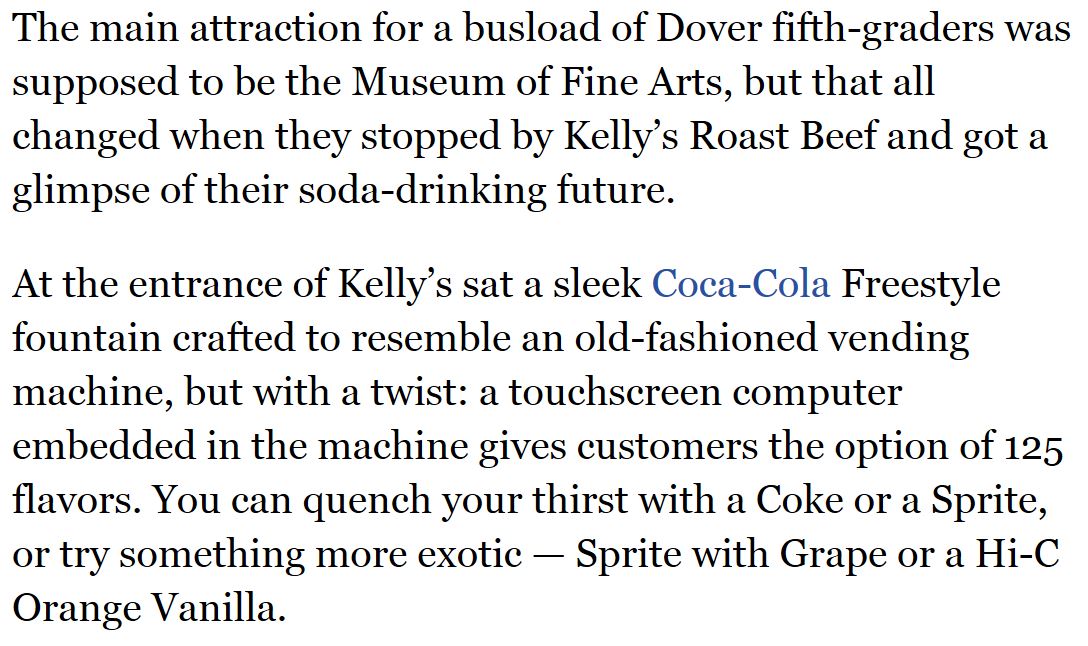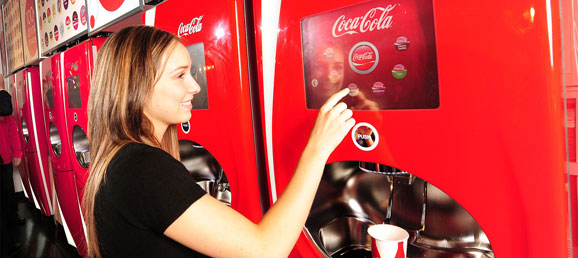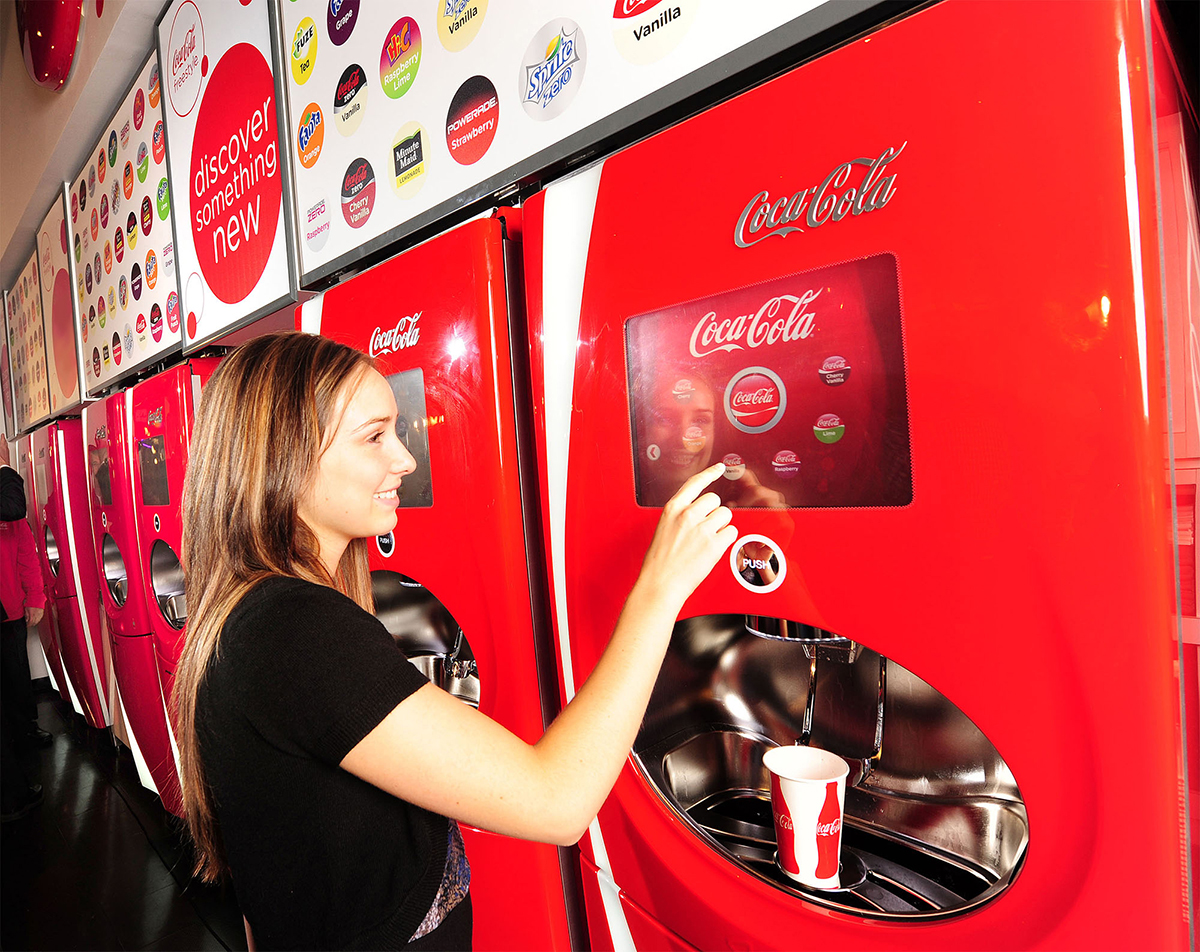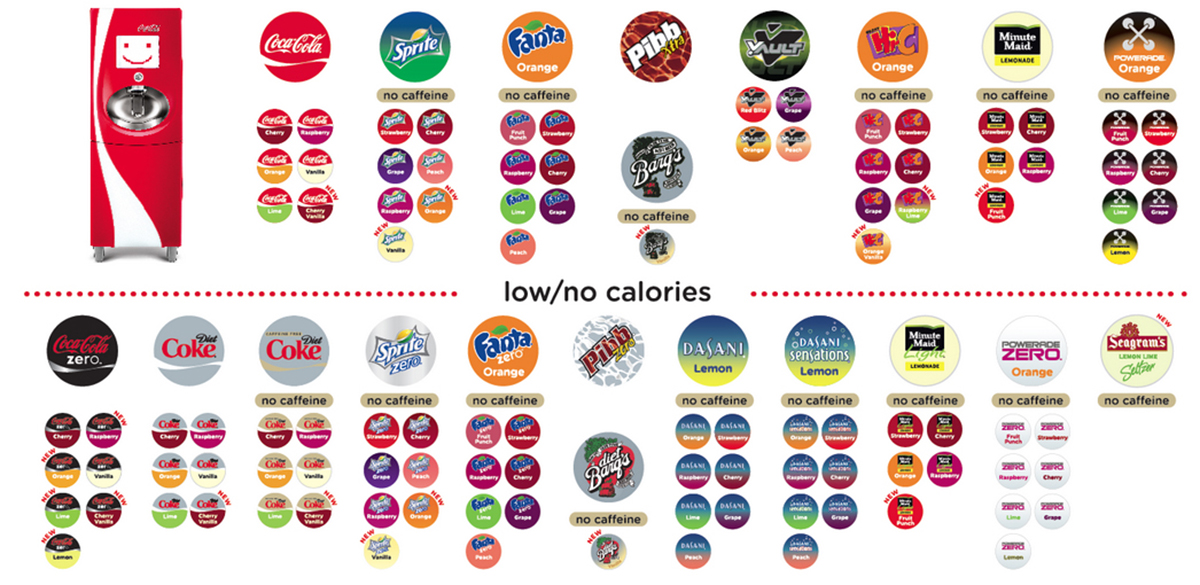- How many soda combinations are there on a Coca-Cola Freestyle?
These questions may be useful in helping students down the problem solving path:
- What is a guess that you know is too low?
- What is a guess that you know is too high?
- Does anyone else have the same answer but another way to explain it?
- What other strategies could we have used to figure out how to count them?
The image below shows a woman using a Coca-Cola Freestyle machine. The drink dispenser allows you to take Coca-Cola soft drinks and add flavors to them including:
- Regular
- Vanilla
- Lime
- Raspberry
- Cherry
- Orange
- Cherry Vanilla
- Lemon
- Strawberry
- Grape
- Peach
- Fruit Punch
- Raspberry Lime
- Orange Vanilla
Not all soft drinks have all of those flavors available as options as most let you only pick a few of them. The image below shows all of the available options for people to choose from on most Coca-Cola Freestyles (a few locations have an additional customized drink). Note that the large circle above each of the sets of flavor choice is also counted as that is the regular flavor.
How you modify the task at this point will determine whether what grade level standards apply. By asking students “How many soda combinations are there on a Coca-Cola Freestyle?” it gives students a context for composing and decomposing numbers. Strategies students may use include (in order of complexity):
- Counting every single flavor one at a time
- Using grouping strategies and noticing that the total number of flavors is equal to 7 + 8 + 8 + 1 + 2 + 5 + 8 + 6 + 8 + 8 + 7 + 7 + 8 + 8 + 1 + 2 + 8 + 8 + 6 + 8 + 1 .
- Realizing they can group the group totals which is equal to 3 * 1 + 2 * 2 + 1 * 5 + 2 * 6 + 3 * 7 + 10 * 8.
- Using invented strategies such as making groups of 6 or other easier to count grouping.
I would definitely look for these three strategies as well as other creative strategies and think about the order you have students present so that the answers build upon each other. Ultimately the total number of flavors comes to 125 flavors. The image below, from Boston.com validates their counting.

- CCSS K.CC.5 – Count to answer “how many?” questions about as many as 20 things arranged in a line, a rectangular array, or a circle, or as many as 10 things in a scattered configuration; given a number from 1-20, count out that many objects.
- CCSS K.CC.6 – Identify whether the number of objects in one group is greater than, less than, or equal to the number of objects in another group, e.g., by using matching and counting strategies.1
-
CCSS K.OA.1 – Represent addition and subtraction with objects, fingers, mental images, drawings1, sounds (e.g., claps), acting out situations, verbal explanations, expressions, or equations.
-
CCSS K.OA.2 – Solve addition and subtraction word problems, and add and subtract within 10, e.g., by using objects or drawings to represent the problem.
-
CCSS K.OA.3 – Decompose numbers less than or equal to 10 into pairs in more than one way, e.g., by using objects or drawings, and record each decomposition by a drawing or equation (e.g., 5 = 2 + 3 and 5 = 4 + 1).
-
CCSS K.OA.4 – For any number from 1 to 9, find the number that makes 10 when added to the given number, e.g., by using objects or drawings, and record the answer with a drawing or equation.
- CCSS K.NBT.1 – Compose and decompose numbers from 11 to 19 into ten ones and some further ones, e.g., by using objects or drawings, and record each composition or decomposition by a drawing or equation (such as 18 = 10 + 8); understand that these numbers are composed of ten ones and one, two, three, four, five, six, seven, eight, or nine ones.
- CCSS K.MD.2 – Directly compare two objects with a measurable attribute in common, to see which object has “more of”/”less of” the attribute, and describe the difference. For example, directly compare the heights of two children and describe one child as taller/shorter.
-
CCSS 1.OA.1 – Use addition and subtraction within 20 to solve word problems involving situations of adding to, taking from, putting together, taking apart, and comparing, with unknowns in all positions, e.g., by using objects, drawings, and equations with a symbol for the unknown number to represent the problem.1
-
CCSS 1.OA.2 – Solve word problems that call for addition of three whole numbers whose sum is less than or equal to 20, e.g., by using objects, drawings, and equations with a symbol for the unknown number to represent the problem.
- CCSS 1.OA.3 – Apply properties of operations as strategies to add and subtract.2 Examples: If 8 + 3 = 11 is known, then 3 + 8 = 11 is also known. (Commutative property of addition.) To add 2 + 6 + 4, the second two numbers can be added to make a ten, so 2 + 6 + 4 = 2 + 10 = 12. (Associative property of addition.)
-
CCSS 1.OA.5 – Relate counting to addition and subtraction (e.g., by counting on 2 to add 2).
-
CCSS 1.OA.6 – Add and subtract within 20, demonstrating fluency for addition and subtraction within 10. Use strategies such as counting on; making ten (e.g., 8 + 6 = 8 + 2 + 4 = 10 + 4 = 14); decomposing a number leading to a ten (e.g., 13 – 4 = 13 – 3 – 1 = 10 – 1 = 9); using the relationship between addition and subtraction (e.g., knowing that 8 + 4 = 12, one knows 12 – 8 = 4); and creating equivalent but easier or known sums (e.g., adding 6 + 7 by creating the known equivalent 6 + 6 + 1 = 12 + 1 = 13).
- CCSS 1.NBT.1 – Count to 120, starting at any number less than 120. In this range, read and write numerals and represent a number of objects with a written numeral.
- CCSS 1.NBT.4 – Add within 100, including adding a two-digit number and a one-digit number, and adding a two-digit number and a multiple of 10, using concrete models or drawings and strategies based on place value, properties of operations, and/or the relationship between addition and subtraction; relate the strategy to a written method and explain the reasoning used. Understand that in adding two-digit numbers, one adds tens and tens, ones and ones; and sometimes it is necessary to compose a ten.
- CCSS 2.OA.1 – Use addition and subtraction within 100 to solve one- and two-step word problems involving situations of adding to, taking from, putting together, taking apart, and comparing, with unknowns in all positions, e.g., by using drawings and equations with a symbol for the unknown number to represent the problem.1
-
CCSS 2.NBT.5 – Fluently add and subtract within 100 using strategies based on place value, properties of operations, and/or the relationship between addition and subtraction.
-
CCSS 2.NBT.6 – Add up to four two-digit numbers using strategies based on place value and properties of operations.
-
CCSS 2.NBT.7 – Add and subtract within 1000, using concrete models or drawings and strategies based on place value, properties of operations, and/or the relationship between addition and subtraction; relate the strategy to a written method. Understand that in adding or subtracting three-digit numbers, one adds or subtracts hundreds and hundreds, tens and tens, ones and ones; and sometimes it is necessary to compose or decompose tens or hundreds.
- CCSS 3.OA.1 – Interpret products of whole numbers, e.g., interpret 5 × 7 as the total number of objects in 5 groups of 7 objects each. For example, describe a context in which a total number of objects can be expressed as 5 × 7.
- CCSS 3.OA.3 – Use multiplication and division within 100 to solve word problems in situations involving equal groups, arrays, and measurement quantities, e.g., by using drawings and equations with a symbol for the unknown number to represent the problem.1
- CCSS 3.OA.5 – Apply properties of operations as strategies to multiply and divide.2 Examples: If 6 × 4 = 24 is known, then 4 × 6 = 24 is also known. (Commutative property of multiplication.) 3 × 5 × 2 can be found by 3 × 5 = 15, then 15 × 2 = 30, or by 5 × 2 = 10, then 3 × 10 = 30. (Associative property of multiplication.) Knowing that 8 × 5 = 40 and 8 × 2 = 16, one can find 8 × 7 as 8 × (5 + 2) = (8 × 5) + (8 × 2) = 40 + 16 = 56. (Distributive property.)
- CCSS 3.OA.8 – Solve two-step word problems using the four operations. Represent these problems using equations with a letter standing for the unknown quantity. Assess the reasonableness of answers using mental computation and estimation strategies including rounding.3





I am finding some of these lessons to be a stretch for all the standards listed. Do you have videos/lessons that better matched to specific grades?
Lessons can be tweaked to be appropriate for different grade levels. For example, you could just have students count portions of the options. Students just did this lesson in 1st grade: https://twitter.com/thomp6j/status/790862476875276288
Thank you, really enjoyed this one. I do these at home with my daughter for extension exercises. It makes math fun!
Is there a place to view the solutions?
It says 125 “I would definitely look for these three strategies as well as other creative strategies and think about the order you have students present so that the answers build upon each other. Ultimately the total number of flavors comes to 125 flavors. The image below, from Boston.com validates their counting.”